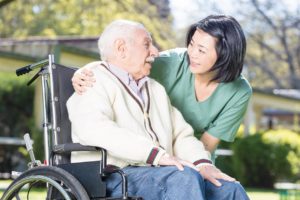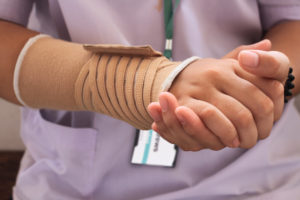September 12, 2018
Safety tips for home health care workers
Due to an aging population and the high cost of hospital visits, there has been increased need for alternative care options for the sick, elderly or disabled. One of these solutions is the use of home health care.
For home health care workers, there is very little control over hazards they are exposed to. They face many unique safety risks while on the job.
Getting to and from work safely
If you are driving to work, make sure your vehicle is in good working order and keep emergency supplies on hand. While travelling, keep your car locked and stay on well-traveled roads. Park in well-light areas and avoid underground parking lots, dark alleys or parking next to large vehicles.
If you are using the bus or walking, stay in well-lit areas with high pedestrian traffic. Be aware of your surroundings, making sure to look and listen. Make sure any oncoming traffic can see you at all times.
Slips and falls
Indoor hazards include:
- Uneven or slippery floors
- Wrinkled or worn carpets and curling vinyl
- Clutter in rooms, hallways and stairs
- Lack of handrails on stairs
- Electrical cords on floors or that cross walkways
- Open drawers
While working indoors, keep your shoes on if allowed by the client and be sure to check the floor surface before walking on it. Watch out for clutter and suggest to the client that items be stored properly, electrical cords get tucked out of the way, and drawers stay closed. Always use handrails when going up and down stairs.
Outdoor hazards include:
- Slippery surfaces, such as sidewalks, steps and wooden ramps covered with water, ice, snow, leaves or moss
- Uneven or damaged sidewalks and driveways
- Debris or items left on walkways
- Poor lighting
Wear footwear with a good tread and check all walking surfaces before taking a step. Move cautiously when exiting your vehicle and when walking on uneven, wet or icy surfaces. Be sure to notify your client representative and supervisor of any hazardous conditions.
Violence prevention in the home
Violence refers to any physical force that may cause injury, as well as threatening statements or behavior. Clients and their family members or visitors may become violent or argumentative due to frustration caused by the client’s condition. Clients may also be experiencing difficulties due to trouble communicating, effects from medication, physical or cognitive limitations or frustration over being dependent on others.
Be sure to read over the care plan before visiting clients. Assess their mood before starting your duties and be sure to tell them what you’re going to do before you do it. Make sure you have easy access from the home.
If a situation becomes stressful, stay calm and face the person with your elbows at your sides and arms out. Watch for signs that the person might strike out. Don’t argue or raise your voice. Reassure the person that their concerns will be dealt with as soon as possible and tell them how to make a complaint to your supervisor. Tell your supervisor about the situation as soon as possible.
Overexertion and repetitive motion
The five main risk factors that cause overexertion and strain from repetitive motion include:
- Force
- Repetition
- Awkward postures
- Static postures
- Contact stress
Signs of overexertion and strain from repetitive movements include:
- Redness
- Swelling
- Loss of normal joint movement
- Shooting, dull, sharp or aching pain
- Tenderness
- Weakness
- Pins and needles
- Hot or cold sensations
Transferring, repositioning, dressing and bathing clients, as well as housekeeping work, can put you at high risk for strains and sprains. Plan your tasks to reduce the potential for injury.
Transferring or repositioning clients
The best way to avoid injury when transferring or repositioning clients is to use equipment and transfer assist devices, such as lifts or low-friction slide sheets. Clearly communicate your intentions and instructions the client. Avoid having a client hold on to you.
If you have to lift manually, it’s important to practice safe patient handling. Lift from a position of power by keeping your head up. Get close to the client while lifting and make sure you have a good hold. Use a staggered stance by positioning one foot in front of the other and remember “nose follows toes” to avoid twisting. Bend your knees and avoid jerking motions.
Dressing and bathing clients
When dressing a client, try to avoid awkward positions, such as reaching to dress the client, and static postures, such as supporting the client in one position for a long time. Keep your body upright and shift your weight with your legs when helping the client move.
Other best practices include starting with the client’s weaker side when putting on clothes, helping your client lean forward when putting on shirts and sitting on a stool when assisting with socks and shoes.
When bathing a client, avoid awkward and static positions, using the same set of muscles repeatedly without a chance to rest and contact stress from kneeling on the floor or leaning against the tub. Be sure to gather all equipment and supplies you need and position them in easy reach. Before you help clients into the tub, be sure to seat them on a transfer bench or shower stool.
Housekeeping hazards
While on the job, there are several household tasks that you might not think are hazardous, including making beds, cleaning and doing laundry.
When making beds, avoid bending at the back and flexing your knees as you make the bed. Walk around the bed instead of reaching over it. If you have to work from one side, keep one hand on the bed for support.
While cleaning, use equipment with long handles for hard to reach areas, place a folded towel under your knees while kneeling and make sure protective gloves fit well to prevent using extra force with gripping.
Carry loads you can comfortably manage while doing laundry. Avoid bending forward, fold clothes at a comfortable height and avoid twisting when lifting.
Resources for home health care workers
- Getting to and from work safely 5-Minute Solution
- Slips and falls 5-Minute Solution
- Violence prevention in the home 5-Minute Solution
- De-escalation Team Training - health care
- Overexertion and repetitive motion 5-Minute Solution
- Transferring or repositioning clients 5-Minute Solution
- Dressing and bathing clients 5-Minute Solution
- Housekeeping hazards 5-Minute Solution





